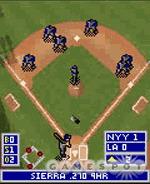From the ancient days of MicroLeague Baseball to the current crop of titles that allow you to control every facet of the game, baseball has long been a favorite of gamers of all stripes. Jamdat MLB 2004 seeks to bring the excitement and thrills of big league baseball to the mobile world. Unfortunately, some glaring issues with the game's artificial intelligence undermine the experience.

MLB 2004 delivers a top-down view of the field that switches from a view of the entire infield to the outfield as appropriate. As with many baseball titles, pitching is a matter of selecting a pitch type and aiming. Defense consists of moving towards a highlighted spot where the ball will land and getting off a quick throw to first base. The challenge in hitting lies in timing and predicting if you face a curveball that might tumble out of the strike zone as you take a hack at it. Defense is primarily up to the game's AI, and at times you may find players moving away from the ball rather than towards it, which is only one of the AI's shortcomings. When pitching, you can aim, select a pitch type, and even alter the ball's direction in flight.
MLB 2004's graphics are average. The game displays the entire infield in one screen shot, leaving the field looking somewhat small and cramped. The players have little detail aside from different colored uniforms. The ball displays some odd behavior, as it seems to travel faster when hit on the ground than in the air. The field is also too small to allow for doubles driven into the gap and similar results.
Like most sports sims based on real world leagues and personalities, Jamdat MLB 2004 rates each player in a number of categories, such as defense and speed. The addition of the player ratings makes it so that your timing and choices are filtered through the ability of the player you control. Since there are a limited number of choices you can make--in essence when to swing or where to place a pitch--the players' ratings play a major role in determining the outcome of a play. This adds a greater strategic element to the game, as you must pay more attention to using relievers, juggling your lineup to create a potent offense, and taking on more of a managerial role. You might have to pitch around a superior hitter to get to the next batter. Defensive ratings play an important enough role that you need to give serious thought to defensive substitutes near the end of a game.
MLB 2004 suffers a noteworthy oddity with respect to player speeds. The players with the highest speed rating can easily make it to first on a bunt, and stealing second and third is a trivial task. The ball simply travels too slowly to catch them. Compounding matters, the game's AI seems to always try to get the lead runner out. If your lead off hitter is fast enough, you can lay down a bunt single, steal second, then steal third. With your next batter, you can have the man on third run towards the plate to draw a throw home, then retreat back to third, allowing the batter to easily make it to first on what would normally be an easy ground out. With this simple strategy, you can load the bases with ease.
MLB 2004's game's strength lies in its comprehensive coverage of major league players, skill ratings, updateable lineups, and online stat tracking. It's just unfortunate that the AI gets in the way of making the game a passable baseball simulation. It's still a decent game, but the boneheaded AI really gets in the way of the game's strong points.